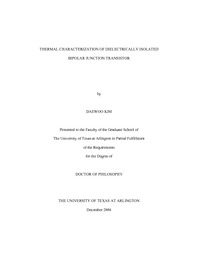
ATTENTION: The works hosted here are being migrated to a new repository that will consolidate resources, improve discoverability, and better show UTA's research impact on the global community. We will update authors as the migration progresses. Please see MavMatrix for more information.
Show simple item record
| dc.contributor.author | Kim, Daewoo | en_US |
| dc.date.accessioned | 2009-09-16T18:20:15Z | |
| dc.date.available | 2009-09-16T18:20:15Z | |
| dc.date.issued | 2009-09-16T18:20:15Z | |
| dc.date.submitted | January 2008 | en_US |
| dc.identifier.other | DISS-10001 | en_US |
| dc.identifier.uri | http://hdl.handle.net/10106/1839 | |
| dc.description.abstract | Since the integrated circuit (IC) was invented in 1960, the operating speed of semiconductor devices has steadily increased and the number of semiconductor devices in an IC chip has grown by a size reduction of the devices. This trend has lead to the rapid increase of power consumption and heat generation. As a result of this increase, thermal characterization of semiconductor devices has become more important.It is especially important to consider thermal characteristics of the dielectrically isolated complementary bipolar junction transistor (DIBJT) which offers many advantages. However, a major disadvantage of this device is an increase in self-heating. Because the DIBJT device is fabricated on the silicon on insulator wafer which has an isolation oxide between bulk wafer and the epitaxial Si layer and also surrounded by an isolation trench which is usually fabricated by oxide or other insulated material, the heat which is generated by the DIBJT device cannot easily transfer to the heat sink which can absorb the heat.This research explored the five elements compact model, which is explained and the alternative method to calculate the each thermal impedance value is proposed for the dielectrically isolated BJT. This method uses the maximum temperature in the BJT. The maximum temperature in the BJT and the estimated junction temperature are compared. There is around 4.7% difference between the total thermal resistance values by using these two temperatures to calculate the total thermal resistance.A new technique for modeling and characterizing of the thermal coupling is proposed. The modified five elements compact model is explained for the thermal coupling between near BJTs. The mathematical model is also explained. The relation of the thermal coupling is a reciprocal proportion to the space between BJTs. The thermal coupling coefficients in series of BJTs are measured and the relation is explained in the mathematical form. These provide some idea for the engineers to design circuits in the thermal point of view.The simulations have done primarily with Davinci and the measurements have done with HP4142B Modular DC Source/Monitor which is interfaced with ICCAP. | en_US |
| dc.description.sponsorship | Carter, Ronald L. | en_US |
| dc.language.iso | EN | en_US |
| dc.publisher | Electrical Engineering | en_US |
| dc.title | Thermal Characterization Of Dielectrically Isolated Bipolar Junction Transistor | en_US |
| dc.type | Ph.D. | en_US |
| dc.contributor.committeeChair | Carter, Ronald L. | en_US |
| dc.degree.department | Electrical Engineering | en_US |
| dc.degree.discipline | Electrical Engineering | en_US |
| dc.degree.grantor | University of Texas at Arlington | en_US |
| dc.degree.level | doctoral | en_US |
| dc.degree.name | Ph.D. | en_US |
| dc.identifier.externalLink | http://www.uta.edu/ra/real/editprofile.php?onlyview=1&pid=226 | |
| dc.identifier.externalLinkDescription | Link to Research Profiles | |
Files in this item
- Name:
- Kim_uta_2502D_10001.pdf
- Size:
- 2.022Mb
- Format:
- PDF
This item appears in the following Collection(s)
Show simple item record


